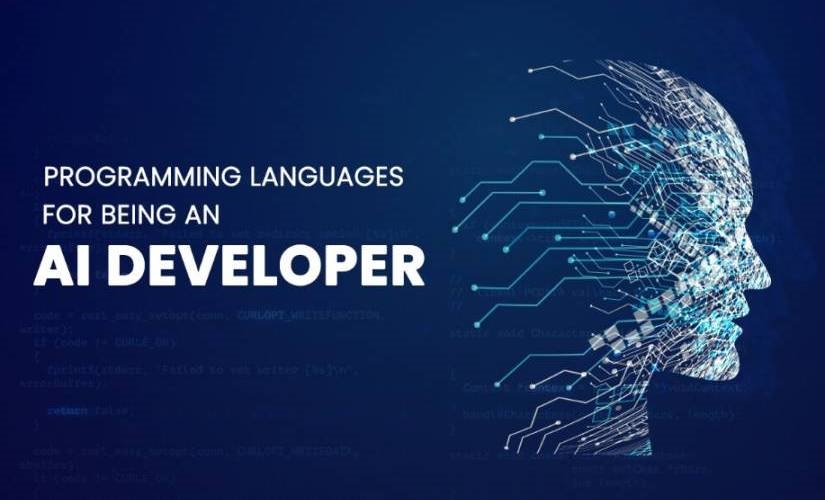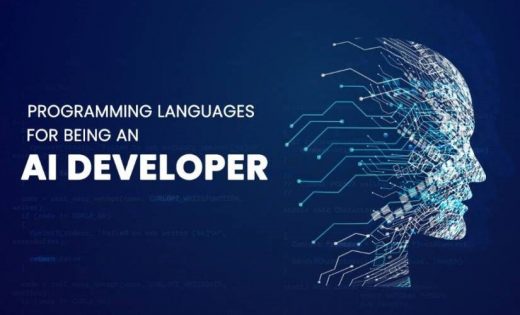Top 10 Programming Languages to Become an AI Developer
Top 10 Programming Languages to Become an AI Developer

Artificial Intelligence (AI) is undergoing a period of intense growth after being stagnant for years. A career path in AI has become a very appealing choice for individuals interested in data science and software engineering, with the demand for AI skilled professionals increasing over these recent years. Here are the top ten programming languages to become an AI developer.
Artificial Intelligence offers businesses and software developers a whole realm of possibilities. AI has brought about a revolution in the technology world, with it still rising and expecting to reach human intelligence.
Required Programming Languages for AI Developers
It is because developers can discover, innovate, and adapt their ability to meet human and organizational needs. Where do you start if you would like to take advantage of this highly in-demand skill?
Top 10 AI Programming languages
Python
Python is an interpreted language, and it is called that because it goes through an interpreter, which turns your code into the language understood by your computer’s processor.
Because of the simplicity and ease of use, Python deserved a chance to be first in the list for Programming languages for AI Developer.
Python’s syntax is very easy and can be learned quickly. This makes it quite simple to implement AI algorithms in it.
Python has been leading in the market with its counterintuitive support and pre-built libraries (like NumPy, Pandas, Pybrain, and SciPy) that help accelerate AI development.
Top features of Python
- It is easy to use
- Interpreted and cross-platform
- Free and open-source
- Object-oriented
- GUI programming support
- Dynamic memory allocation
Java
Java is a highly versatile, robust, and transparent language supported by several libraries. Ever since it first appeared in 1995, it has seen a huge growth in the market. Java is also very user-friendly, easy-to-debug, and runs through platforms without engaging in additional recompilation.
The Java-code can be run on any Java-supported platform with its Virtual Machine technology. Artificial intelligence does indeed have a lot to do with search algorithms, genetic programming, and artificial neural networks, making it one of the ideal choices for Programming languages for AI Developers.
Top features of Java
- It is simple and easy to use
- It is an object-oriented language.
- Platform independent
- Secured and robust
- Architecture neutral
- Interpreted language
- Multithreaded
Julia
Julia is a high-level, efficient, and dynamic programming language. While it is a general-purpose language and can be used to write any application, many of its features are well-suited for numerical computing that’s required by AI.
The central framework for programming involves a parametric polymorphism and multiple dispatch mechanism. In comparison to the above languages, Julia might not sound like an ideal choice.
As a consequence, a substantial number of libraries or a quickly evolving community do not support it. However, Wrappers like TensorFlow.jl and Mocha provide excellent support for DL.
Top features of Julia
- It is fast and dynamic
- It is reproducible
- It is composable
- It is open-source
- Provides asynchronous I/O, metaprogramming, debugging, logging, profiling, a package manager
LISP
Lisp is one of the oldest and most appropriate languages for AI development. It was introduced by the father of Artificial Intelligence, John McCarthy, in the year 1958.
It has the capacity to process symbolic data successfully. Lisp can be represented as a mathematical notation for computer programs. AI developers frequently turn to Lisp for a series of AI projects that are ML centric.
LISP is renowned for its outstanding prototype capabilities with automated garbage collection and the simple dynamic development of new objects. It has an integrated development cycle for analyzing expressions and recompiling functions or files when the program is still running.
Top features of LISP
- It is machine-independent
- It an iterative design methodology
- It provides high level debugging.
- It is an object-oriented language.
- It is expression-based.
- Provides a complete I/O library.
Scala
Scala comes from the JVM family, much the same as Java. Scala is a relatively new language in the AI domain. Recently several companies and start-ups have incorporated it into their business, allowing it to gain some recognition.
Developers from all around the world like Scala because of the many features that it has to offer. Also, ScalaNLP, DeepLearning4j, etc., are some of the tools that facilitate the smooth AI developing process with Scala.
It is ideal for projects that need versatility. It merges the advantages of functional and imperative programming models while serving as a strong tool that helps to create highly competitive applications while, at the same time, harnessing the strengths of an OO approach.
Top features of Scala
- Type inference.
- Singleton object.
- Immutability.
- Case classes and Pattern matching.
- Concurrency control.
- String interpolation.
- Higher-order function.
R
R is one of the most powerful languages and environments for statistical analysis and manipulation of data.
In addition to being an open-source and general-purpose language, R includes several packages, including RODBC, Gmodels, Class, and Tm that are also being used in machine learning.
These packages implement machine learning algorithms quite simply. Statistics form the basis of ML, and AI and R are popularly known to revolve around statistics a lot.
R is considered to be similar to the popular statistical applications SAS and SPSS. It is suitable for data analysis, visualization, and general statistics.
However, compared to Python, it is less versatile but also more specialized.
Top features of R
- It is free and open-source
- It is robust and highly extensible
- Effective data handling
- It provides a storage facility
- Integrates with C/C++, Java, Python, etc.
- It is platform-independent
Haskell
Haskell is a general-purpose, statically typed, purely functional programming language. It was developed in the 1990s with non-strict semantics.
It gained popularity in academic circles but was soon known to be used by tech giants like Facebook and Google. Haskell is being used for research as it supports embedded domain languages, which play a large role in programming language research and AI.
Unlike Java. Haskell is ideal for dealing with abstract mathematics because it enables libraries to construct expressive and efficient AI algorithms.
HLearn, for instance, uses regular algebraic structures such as modules and monoids for expressing and speeding up basic ML algorithms.
Top features of Haskell
- It is a functional language
- Modularity
- Statically typed
- It is easy and cost-effective
- Lazy language
Rust
Rust is a multi-paradigm programming language boasting of being secure, efficient, and safe concurrency.
Rust is syntactically similar to C++ and provides memory safety without using garbage collection. Rust has actually been chosen in Stack Overflow’s annual developer surveys for the last 4 years as the most popular and most loved language that fills the void that can be found in other languages.
The newly open-sourced Verona Project also uses Rust principles, an emerging language that may allow Microsoft to safely maintain legacy C and C# code.
Mozilla Research defines Rust as a “systems programming language that focuses on speed, memory safety, and parallelism.”
Top features of Rust
- Zero cost abstraction.
- Pattern matching.
- Error messages.
- Move semantics.
- Threads without data races.
- Guaranteed memory safety.
- Safe memory space allocation.
Prolog
Prolog is a logic programming language associated with artificial intelligence and computational linguistics. When we talk about programming languages for AI developers, this language stands next to Lisp.
Efficient pattern matching, tree-based data structuring, and automated backtracking are some of this language’s features. These features provide a remarkably strong and versatile structure for programming.
Prolog is commonly used in medical projects as well as the production of AI systems for experts.
Top features of Prolog
- It is a declarative language
- It uses the language of predicate calculus.
- It manages lists and recursion naturally.
- It is a fully object-oriented language.
- Pattern matching and unification
- It supports direct linkage with C/C++.
MATLAB
MATLAB is a proprietary multi-paradigm programming language and numerical computing environment that is introduced by MathWorks.
The use of Matlab is suggested for complex mathematical functions. Matlab offers AI capabilities like Caffe and TensorFlow. It helps you to incorporate AI into the entire workflow.
In a sense, even without machine learning knowledge and experience, you can work around AI with MATLAB. You can use applications and easily play with various approaches.
Top features of MATLAB
- It is a high-Level language.
- Interactive environment.
- Handling graphics.
- Mathematical functions library.
- Application program interface (API).
- Interfacing with other languages.
- It provides built-in graphics.
To Sum Up
Artificial intelligence is a branch of engineering that ultimately seeks to render intelligent computers and to target the way an intelligent human thinks. There are unique features and advantages of each language.
However, you have to select the perfect language for your AI projects as an AI Engineer and not just follow the herd blindly. It is best to learn about each language individually and then understand if those will work in your favor.
Also, the selection of programming language for AI often depends on a variety of main factors. Consider your business type, whether you are just getting started or already have a setup, how the market looks, who your clients or customers are, what problems you are trying to solve and what your objectives are, etc.
Besides that, many solutions are not dependent on one technology alone. So, keep the experimentation on until you find that ideal language.
The post Top 10 Programming Languages to Become an AI Developer appeared first on ReadWrite.
(50)


